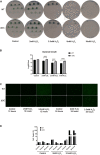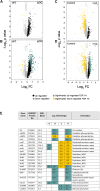The Role of Pseudo-Orthocaspase (SyOC) of Synechocystis sp. PCC 6803 in Attenuating the Effect of Oxidative Stress
- PMID: 33613507
- PMCID: PMC7889975
- DOI: 10.3389/fmicb.2021.634366
The Role of Pseudo-Orthocaspase (SyOC) of Synechocystis sp. PCC 6803 in Attenuating the Effect of Oxidative Stress
Abstract
Caspases are proteases, best known for their involvement in the execution of apoptosis-a subtype of programmed cell death, which occurs only in animals. These proteases are composed of two structural building blocks: a proteolytically active p20 domain and a regulatory p10 domain. Although structural homologs appear in representatives of all other organisms, their functional homology, i.e., cell death depending on their proteolytical activity, is still much disputed. Additionally, pseudo-caspases and pseudo-metacaspases, in which the catalytic histidine-cysteine dyad is substituted with non-proteolytic amino acid residues, were shown to be involved in cell death programs. Here, we present the involvement of a pseudo-orthocaspase (SyOC), a prokaryotic caspase-homolog lacking the p10 domain, in oxidative stress in the model cyanobacterium Synechocystis sp. PCC 6803. To study the in vivo impact of this pseudo-protease during oxidative stress its gene expression during exposure to H2O2 was monitored by RT-qPCR. Furthermore, a knock-out mutant lacking the pseudo-orthocaspase gene was designed, and its survival and growth rates were compared to wild type cells as well as its proteome. Deletion of SyOC led to cells with a higher tolerance toward oxidative stress, suggesting that this protein may be involved in a pro-death pathway.
Keywords: Synechocystis sp. PCC6803; orthocaspase; programmed cell death; proteomics; pseudo-enzyme.
Copyright © 2021 Lema A, Klemenčič, Völlmy, Altelaar and Funk.
Conflict of interest statement
The authors declare that the research was conducted in the absence of any commercial or financial relationships that could be construed as a potential conflict of interest.
Figures





Similar articles
-
Phylogenetic Distribution and Diversity of Bacterial Pseudo-Orthocaspases Underline Their Putative Role in Photosynthesis.Front Plant Sci. 2019 Mar 14;10:293. doi: 10.3389/fpls.2019.00293. eCollection 2019. Front Plant Sci. 2019. PMID: 30923531 Free PMC article.
-
Structural and functional diversity of caspase homologues in non-metazoan organisms.Protoplasma. 2018 Jan;255(1):387-397. doi: 10.1007/s00709-017-1145-5. Epub 2017 Jul 25. Protoplasma. 2018. PMID: 28744694 Free PMC article. Review.
-
Inactivation of the Deg protease family in the cyanobacterium Synechocystis sp. PCC 6803 has impact on the outer cell layers.J Photochem Photobiol B. 2015 Nov;152(Pt B):383-94. doi: 10.1016/j.jphotobiol.2015.05.007. Epub 2015 May 22. J Photochem Photobiol B. 2015. PMID: 26051963
-
The art of destruction: revealing the proteolytic capacity of bacterial caspase homologs.Mol Microbiol. 2015 Oct;98(1):1-6. doi: 10.1111/mmi.13111. Epub 2015 Jul 22. Mol Microbiol. 2015. PMID: 26123017
-
Evolution and structural diversity of metacaspases.J Exp Bot. 2019 Apr 12;70(7):2039-2047. doi: 10.1093/jxb/erz082. J Exp Bot. 2019. PMID: 30921456 Review.
Cited by
-
Cell Death in Cyanobacteria: Current Understanding and Recommendations for a Consensus on Its Nomenclature.Front Microbiol. 2021 Mar 3;12:631654. doi: 10.3389/fmicb.2021.631654. eCollection 2021. Front Microbiol. 2021. PMID: 33746925 Free PMC article. Review.
References
-
- Berman-Frank I., Bidle K. D., Haramaty L., Falkowski P. G. (2004). The demise of the marine cyanobacterium, Trichodesmium spp., via an autocatalyzed cell death pathway. Limnol. Oceanogr. 49 997–1005. 10.4319/lo.2004.49.4.0997 - DOI
LinkOut - more resources
Full Text Sources
Other Literature Sources
Molecular Biology Databases

